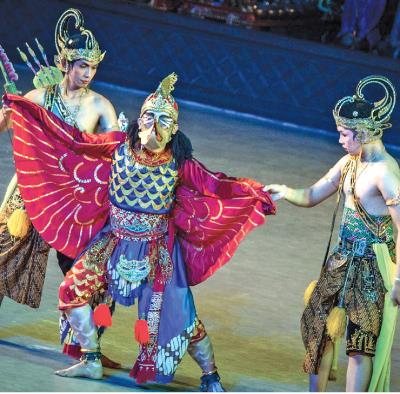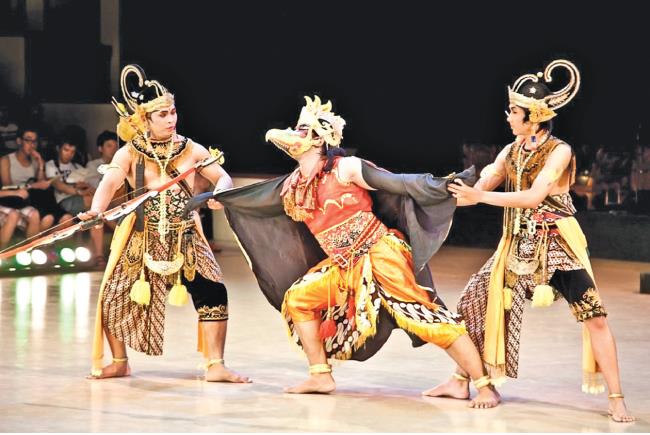
Ramayana In The History Of Sri Lankan Malays
Colombo, December 14: Sri Lanka is central to the Hindu epic the Ramayana, being the scene of the battle between the Indian king Rama and the Sri Lankan monarch Rawana. However, the Ramayana story has never been part of the lived culture of the Sinhalese, the majority community in the island.
Traditional Sinhalese Buddhist literature had ignored the Ramayana condemning it as“idle talk”, though in the Kelaniya temple, Rawana and his brother Vibhishana were worshiped as devotees of the Buddha.
ADVERTISEMENTBut strangely enough, the Ramayana had an important place in the unlikeliest places in Southern Sri Lanka, the Muslim Malay community.
Ronit Ricci of the Australian Nation University in her book: Banishment and Belonging (Cambridge University Press and Tambapanni Academic Publishers) says that the Malays brought the Ramayana with them when they were brought to Sri Lanka by the Dutch in the 17th Century.
Back in their homeland –Java- in present-day Indonesia, the story of Rama, Sita and Rawana, was part of the Malay or Javanese lived-in culture, inherited from their past which was heavily influenced by Hinduism and Buddhism.
In Java, as in the rest of South East Asia, the Ramayana was part of the local folk culture from the 9th Century AD onwards due to the influence of Hindu traders from India. Ricci says that the earliest written version of the Malay Ramayana was the Kakawin Ramayana. The author of this poetic work was Yogiswara.
According to Ricci, the location of the 9th Century Parambanan temple in Java, which is associated with the Ramayana, was originally known as“Langkapura”. In fact, the Ramayana is staged daily at this temple to date.
The next major version of the Javanese Ramayana was the Hikayat Seri Rama (Chronicle of The Great Rama) written in phases between the 13th and 17th Centuries. The Hikayat Seri Rama is generally regarded as an embodiment of the cultural ideals of the Javanese ruling elite. These ideals were an admixture of Hinduism and Islam.
There are traces of Tamil and Jain Ramayanas in Hikayat Seri Rama as well the Hikayat Maharaja Rawana (The Story of King Rawana). For example, the Tamil and Malay Ramayanas portray Sita as Rawana's daughter and not King Janaka's. And Tamil words are used. For example, there is a line which says that Sita ate mam palam (Tamil for ripe mango) while in captivity in Sri Lanka.
Though the Ramayana is a Hindu-Indian story, the Hikayat Seri Rama uses Islamic terminology and Islamic references. Ricci describes it as“a monument to the kind of connections and syntheses that were forged during the transition from pre-Islamic to Islamic culture in the Malay world.”
The influence of the Ramayana survived in Java over centuries despite conversion to Islam which took place between the 13th and the 16th Centuries due to Muslim traders from India and the Arab world.
These traders brought with them an Islam which combined Islamic and non-Islamic folk beliefs. It is in this context that Javanese/Malay Islam accommodated the Ramayana and other Hindu beliefs.
For example, Cerat Cabolek is a Javanese manuscript that illustrated the dialectic between Islam and Javanese traditions in the 18th and 19th centuries. According to Cerat Cabolek the Ramayana and the Arjuna Wiwaha were works of Islamic mysticism that contained all the necessary teachings for one to lead a virtuous life.
The Babad Tanah Jawi (History of the Land of Java) also has stories paralleling the Ramayana. Just as Bharatha in the Ramayana refused to sit on the throne of Ayodhya saying the rightful king was not he, but his exiled elder brother Rama, Pakubuwana II of the Javanese kingdom of Kartasura refused to sit on the throne in 1726 saying the seat should rightfully go to his elder brother, Pangeran Arya Mangkuagara.
In Sri Lanka, the Ramayana was very much a part of Malay culture from the 17th to the late 19th Century, even as the Malays continued to practice Islam. However, with Islamization getting an international boost in the second half of the 20 th Century, non-Islamic traits disappeared from Sri Lankan Malay culture.
For the Malay expatriates or exiles in Sri Lanka, the Hikayat Seri Rama was more than the story of the banishment of Rama and Sita to“Langkapura”. The banishment of Rama and Sita seemed to parallel their own banishment from Java.
And just as the“Lanka” of the Ramayana was ruled by a powerful demon-king Rawana, the Malays'“Langkapura” was also ruled by a demon, and that demon was the intolerant and exploitative Dutch. The Malays of Sri Lanka welcomed the defeat of the Dutch by the British at the end of the 18th Century and the establishment of British rule.

A scene from the Javanese Ramayana
The first Sri Lankan Malay language newspaper in the Jawi script Alamat Langkapuri, was started in 1869 by Baba Ounus Saldin. He described British rule as“bright sunshine” in contrast to the“darkness” that marked Dutch rule.
An expert on the Malays in Sri Lanka under British rule, Dr. B.A. Hussainmiya, pointed out that the community gained from British rule because of recruitment to the Ceylon Rifle Regiment, also called the Orang Rejimen. The children of Malay soldiers in the regiment got an English education which enabled them to enter Government Service when the British opened it to Sri Lankans.
In the Ramayana, banishment to Lanka was very hard on Sita. Similarly, the banishment from Java to Sri Lanka was hard on the Malay exiles and soldiers until much later when conditions improved. The yearning to go back to Java was strong in the 18th Century, just as Sita's yearning to go back to Rama and Ayodhya in India was.
In the texts known as Wasilan (containing charms and incantations recited in life-threatening situations) the Ramayana's concept of Lakshmana Rekha (the line one will cross only at one's peril) is evoked. The Lakshmana Rekha was a powerful boundary drawn around Sita in the forest that would have saved her from the abductor Rawana had she not been careless and crossed it.
The Garisan Laksamana is a Wasilan chant that was used by Malays in situations of mortal danger. It was believed that chanting it would result in the perceived danger disappearing or the aggressor dropping dead. Malay soldiers in battle were advised to recite the Garisan Laksamana at the right moment for maximum effect.
According to Ricci, there are two voluminous copies of the Hikayat Seri Rama in Sri Lanka. They contain a story which draws a parallel between Rawana and Adam (referred to as Nabi Adam in the Islamic way). Both of them defied a solemn pledge and incurred banishment.
According to the Hikayat Seri Rama, Rawana was a very strong child but was also wild. He was banished for this by his grandfather Bermaraja, the ruler of Lanka. Rawana, then just 12, indulged in the severe penance of hanging upside down from a tree at the foot of Mount Sarandib (Adam's Peak) for twelve years continuously.
Nabi Adam, who was also there, having been banished from heaven by Allah for disobeying him, spotted Rawana and told him that he could help him get his rightful place in his Kingdom if he would only promise to strictly obey a set of divine commandments that would make him a just ruler of a vast domain.
Rawana took the pledge and got to rule his kingdom. But he broke the pledge by abducting Sita. And in the war with Rama, which followed, Rawana suffered a humiliating defeat and lost his Kingdom.
END

Legal Disclaimer:
MENAFN provides the
information “as is” without warranty of any kind. We do not accept
any responsibility or liability for the accuracy, content, images,
videos, licenses, completeness, legality, or reliability of the information
contained in this article. If you have any complaints or copyright
issues related to this article, kindly contact the provider above.


















Comments
No comment